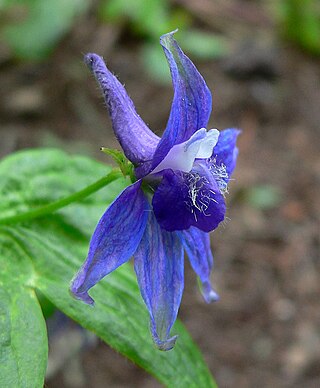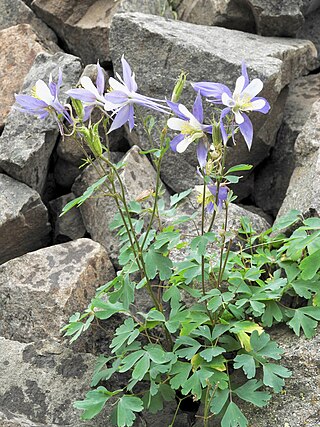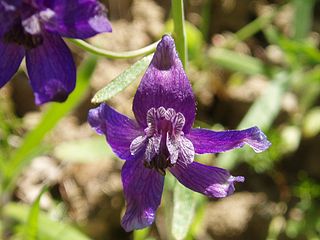
Delphinium is a genus of about 300 species of annual and perennial flowering plants in the family Ranunculaceae, native throughout the Northern Hemisphere and also on the high mountains of tropical Africa. The genus was erected by Carl Linnaeus.

Delphinium bakeri, or Baker's larkspur, is a species of perennial herb in the buttercup family, Ranunculaceae. It is endemic to California in the United States, where it is a federally listed endangered species. It is known in the wild from one remaining occurrence near Salmon Creek in Sonoma County, where only seven plants remained as of March 2006.

Aquilegia coerulea, the Colorado columbine, Rocky Mountain columbine, or blue columbine, is a species of flowering plant in the buttercup family Ranunculaceae, native to the Rocky Mountains and some of the surrounding states of the western United States. It is the state flower of Colorado. The Latin specific name coerulea means "sky blue".

Delphinium patens is a species of larkspur known by the common names zigzag larkspur and spreading larkspur. It is a wildflower limited mainly to California. Though not yet confirmed there, it is expected in Baja California. Plants grow typically 20 to 50 centimeters tall and bear up to 36 flowers each. The stems are mostly hairless, have reddish bases, and bears leaves on the lower half. Each leaf is divided into 3 to 9 lobes. The flower has dark blue sepals, the latter ones reflexed. The spur at the back of the flower is 4 to 8 millimeters long. The cleft at the center of the flower has white or yellowish scattered hairs. The elongated fruit is one or two centimeters long and contains pitted seeds.

Aconitum columbianum is a species of flowering plant in the buttercup family known by the common names Columbian monkshood or western monkshood.
Delphinium decorum is a species of larkspur known by the common names coastal larkspur and yellow-tinge larkspur. This wildflower is native to California and Oregon, where it grows on the slopes of the coastal ranges from the San Francisco Bay Area north to the southern Oregon coast. It has an erect stem which approaches half a meter in height at maximum. The leaves, which are divided into a number of narrow lobes, are mostly located about the base of the plant. The spindly stem above bears two to twenty widely spaced flowers. Each flower is carried on a pedicel several centimeters long. The five long, flat sepals are extended to give the face of the flower a star shape, and they are usually deep blue to purple. The petals are similar in color, except the top two may be lighter to almost white. The spur is very thin and may be nearly two centimeters long.

Delphinium depauperatum is a species of larkspur known by the common names slim larkspur and dwarf larkspur. This wildflower is native to western North America where it is found in mountain meadows. It grows from a short root and erects a stem usually under 40 centimeters in maximum height. The small leaves are divided into lobes and are usually located about the base of the plant. Toward the top of the stem are flowers on long pedicels, with usually not more than 20 flowers per plant. The flowers generally have deep dark blue sepals which are flat and extended to the sides, and petals which are mainly the same color except for the top two, which may be lighter blue to white. The spur is between one and two centimeters long.

Delphinium variegatum is a species of larkspur known by the common name royal larkspur. It is endemic to California, where it grows in mountains, valley and coast in woodlands and grasslands. On the forest floor of California oak woodlands typical plant associates are Calochortus luteus, Cynoglossum grande and Calochortus amabilis.

Gilia capitata is a species of flowering plant in the phlox family known by the common names blue-thimble-flower, bluehead gilia, blue field gilia, and globe gilia.

Caltha leptosepala, the white marsh marigold, twinflowered marsh marigold, or broadleaved marsh marigold, is a North American species of flowering plant in the buttercup family. The species has regionally distinct variations.

Delphinium polycladon is a species of larkspur known by the common name mountain marsh larkspur. It is native to the High Sierra Nevada and the White and Inyo Mountains of eastern California and far western Nevada, where it grows in wet sites in the talus. It is a perennial herb producing one or more erect stems which easily exceed a meter in height but often remain dwarfed in high-elevation, exposed habitat with thin soils. The leaves are small and mostly located near the base of the plant. The inflorescence is a raceme of up to 35 flowers on long, S-shaped pedicels, often arranged along one side of the stem. The sepals are deep blue to purple, one to two centimeters long, and with a spur up to 2 centimeters in length.

Orobanche californica, known by the common name California broomrape, is a species of broomrape. It is a parasitic plant growing attached to the roots of other plants, usually members of the Asteraceae.

Sagina decumbens is a species of flowering plant in the family Caryophyllaceae known by the common names trailing pearlwort and western pearlwort. It is native to several areas of North America, where it can be found in many types of habitat. It is a small annual herb producing a threadlike green or purplish stem growing erect or trailing, measuring up to about 16 centimeters long. The leaves are hairless, linear in shape, and one half to two centimeters long. The inflorescence is a solitary flower borne on a threadlike pedicel. The flower has usually five sepals and five tiny white petals. There are two subspecies which differ mainly in the microscopic appearance of the seeds.

Silene scouleri is a species of flowering plant in the family Caryophyllaceae known by the common names simple campion and Scouler's catchfly.
Streptanthus insignis is an uncommon species of flowering plant in the mustard family known by the common names plumed jewelflower and San Benito jewelflower. It is endemic to California, where it is known only from the Inner Central Coast Ranges. It grows in grassland and chaparral habitat, usually on serpentine soils. It is an annual herb producing a hairy, bristly, branching stem up to about 60 centimeters long. The lance-shaped basal leaves are borne on short petioles. Leaves midway up the stem are longer, and those near the top are shorter. They sometimes clasp the stem at their bases. Flowers occur at intervals along the upper stem. The uppermost flowers are often sterile and different in form. Each fertile flower has a bell-shaped calyx of sepals which is purple or greenish-yellow depending on subspecies. The petals at the tip are purplish or yellowish, also depending on subspecies. The fruit is a flat, straight silique which may be over 11 centimeters long.

Paronychia chartacea is a rare species of flowering plant in the family Caryophyllaceae known by the common names papery Whitlow-wort and paper nailwort. It is endemic to Florida in the United States. There are two subspecies of the plant; ssp. chartacea occurs in Central Florida, especially the Lake Wales Ridge, and ssp. minima is native to the Florida Panhandle. The two subspecies are geographically separated and do not occur together. Both are included on the federal Endangered Species List, on which the species is designated threatened.

Symphyotrichum lanceolatum is a species of flowering plant in the family Asteraceae native to North America. Common names include panicled aster, lance-leaved aster, and white panicled aster. It is a perennial, herbaceous plant that may reach 1.5 meters tall or more, sometimes approaching 2 m. The lance-shaped leaves are generally hairless but may feel slightly rough to the touch on the top because of tiny bristles. The flowers grow in clusters and branch in panicles. They have 16–50 white ray florets that are up to 14 millimeters long and sometimes tinged pink or purple. The flower centers consist of disk florets that begin as yellow and become purple as they mature.
Delphinium robustum is a species of flowering plant in the buttercup family known by the common names Wahatoya Creek larkspur and robust larkspur. It is native to Colorado and New Mexico in the United States.

Dudleya attenuata is a species of perennial succulent plant known by the common name taper-tip liveforever, native to Baja California and a small portion of California. It is a rosette-forming leaf succulent which has narrow pencil-shaped leaves that can often be found covered in a white epicuticular wax. The thin, sprawling stems branch to form the clusters of rosettes, with plants creating a "clump" up to 40 cm wide. The small flowers are white or yellow, with 5 spreading petals. It is a diverse, variable species that extends from the southernmost coast of San Diego County to an area slightly north of the Vizcaino Desert, hybridizing with many other species of Dudleya in its range. Some plants with white or pinkish flowers were referred to as Orcutt's liveforever, referring to a former subspecies split on the basis of the flower color.

Dudleya saxosasubsp. aloides is a species of perennial succulent plant in the family Crassulaceae known by the common names desert dudleya or desert savior. It is a rosette-forming species widely distributed throughout the Peninsular Ranges and desert mountains of California in the United States. It is characterized by bright-yellow or greenish-yellow flowers, and can be found in shaded crevices and slopes. Plants in western half of the range may grade into Dudleya lanceolata.


















